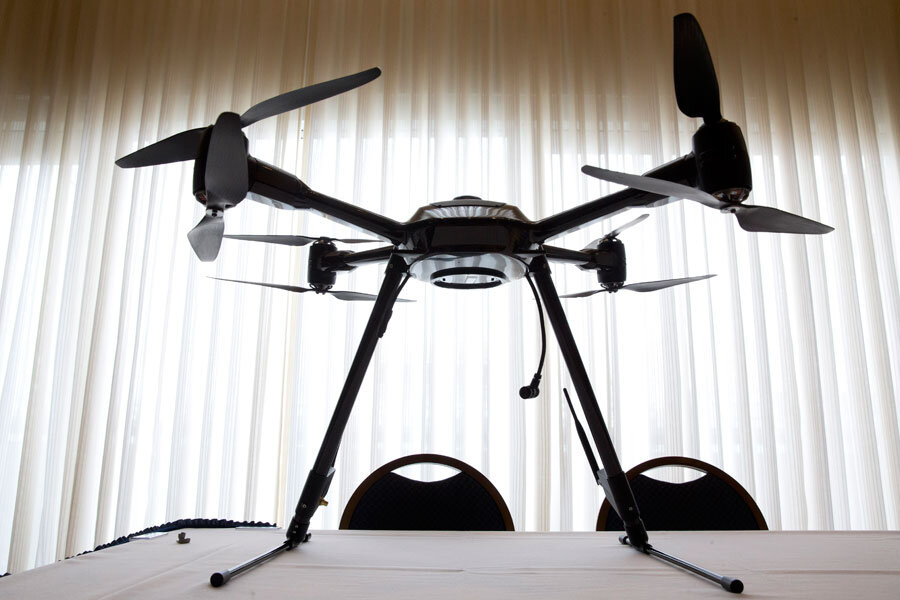FAA to release new drone rules: Will Amazon get what it wants?
Loading...
The Federal Aviation Administration reportedly could release on Sunday much-awaited regulations for how businesses can use drones in American airspace – a first step toward defining how to plumb the enormous utility of unmanned aircraft while maintaining public safety and individual privacy rights.
Early indications are that the regulations are more lenient than many experts expected but a far cry from giving Amazon drones the go-ahead to begin dropping boxes of turkey basters in your backyard. The initial emphasis will be on enabling small-bore commercial applications where drone technology can improve efficiency and workplace safety, notes an analysis by Forbes.
While businesses are likely to be encouraged by this step, critics worry that the FAA is moving too slowly on the broader issue. As drones become smaller, more sophisticated, and more widely available, some observers suggest that a narrow set of guidelines covering only business applications is not nearly enough to rein in potential Peeping Toms or terrorists.
The drone genie is out of the bottle, they say, and the FAA is falling further and further behind the realities in the skies.
An economic analysis of the forthcoming plan, which was accidentally posted online before being deleted, points to the acceptable commercial uses for small drones (under 55 pounds) going forward. It suggests that the deaths of 95 climbers working on cell towers could have been avoided had drones been deployed. Likewise, drones could be invaluable in helping authorities to conduct 45,000 bridge inspections a year. The document highlights drones' utility in helping farmers manage their fields with much greater precision and helping law enforcement conduct search and rescue.
Given these modest applications, the FAA will keep operating guidelines modest. Drones can only be operated within line-of-sight, for example. In other words, if you can't see your drone, you can't fly it. In order to avoid any potential problems with air traffic, drones will have to stay below 500 feet. And they can be flown only between sunrise and sunset.
By tailoring drone use to fairly narrow conditions and applications, the FAA feels comfortable imposing far fewer regulations on who can fly them and how much training and inspection is needed. A pilot's license, for instance, will not be required. And the FAA will keep maintenance and permitting regulations to a minimum, according to reports.
"The term 'minimal regulatory burden' or a variant thereof is a key theme throughout the document," writes Gregory McNeal of Forbes. "If the economic analysis ends up reflecting a true assessment of the proposed rule, many drone advocates will be very happy with the FAA and their decision to regulate the lowest-risk small UAS [unmanned aircraft system] operations by imposing a minimal regulatory burden on those operations."
What the rules will not allow is the sort of applications envisioned by Amazon. The online retailer is testing a service called Amazon Prime Air, in which customers in certain locations could choose drone delivery of their order within 30 minutes.
Amazon has been battling with the FAA over the federal agency's refusal to let the company conduct outdoor tests. But an organization lobbying on behalf of Amazon and others calls the new regulations a positive step.
"This is a wonderful start," Michael Drobac, executive director of the Washington-based Small UAV Coalition, told Bloomberg Business.
The regulations, however, do not cover amateur enthusiasts, who are still operating under somewhat similar rules created years ago to govern remote-controlled airplanes. That area of regulation is in dire need of an update, say critics. The tiny, four-rotor "quadchopper" drone that a civilian landed on the White House grounds was only a taste of the challenges ahead, they say.
"All of this makes it seem very difficult to justify leaving small [amateur] drones like the quadchoppers subject to voluntary rules about the safe use of airspace while, at the same time, licensing and regulating a new professional class of pilots to handle heavier and far more expensive commercial drones," writes Clive Irving at The Daily Beast. "The very idea of a double standard – different grades of competence for different kinds of machines – is unprecedented."








